Exploration of a Pathophysiology Case
VerifiedAdded on 2023/06/15
|8
|2386
|201
AI Summary
This essay explores the pathophysiology of cerebrovascular accident (CVA) in a 75-year-old widow, Ms. Greta Balodis, following her deterioration in health and diagnosis of CVA. The essay explains the signs and symptoms of CVA and suggests pharmacological intervention and physical therapies to restore her mobility.
Contribute Materials
Your contribution can guide someone’s learning journey. Share your
documents today.

Running head: EXPLORATION OF A PATHOPHYSIOLOGY CASE
Assessment 1
Name of the Student
Name of the University
Author Note
Assessment 1
Name of the Student
Name of the University
Author Note
Secure Best Marks with AI Grader
Need help grading? Try our AI Grader for instant feedback on your assignments.
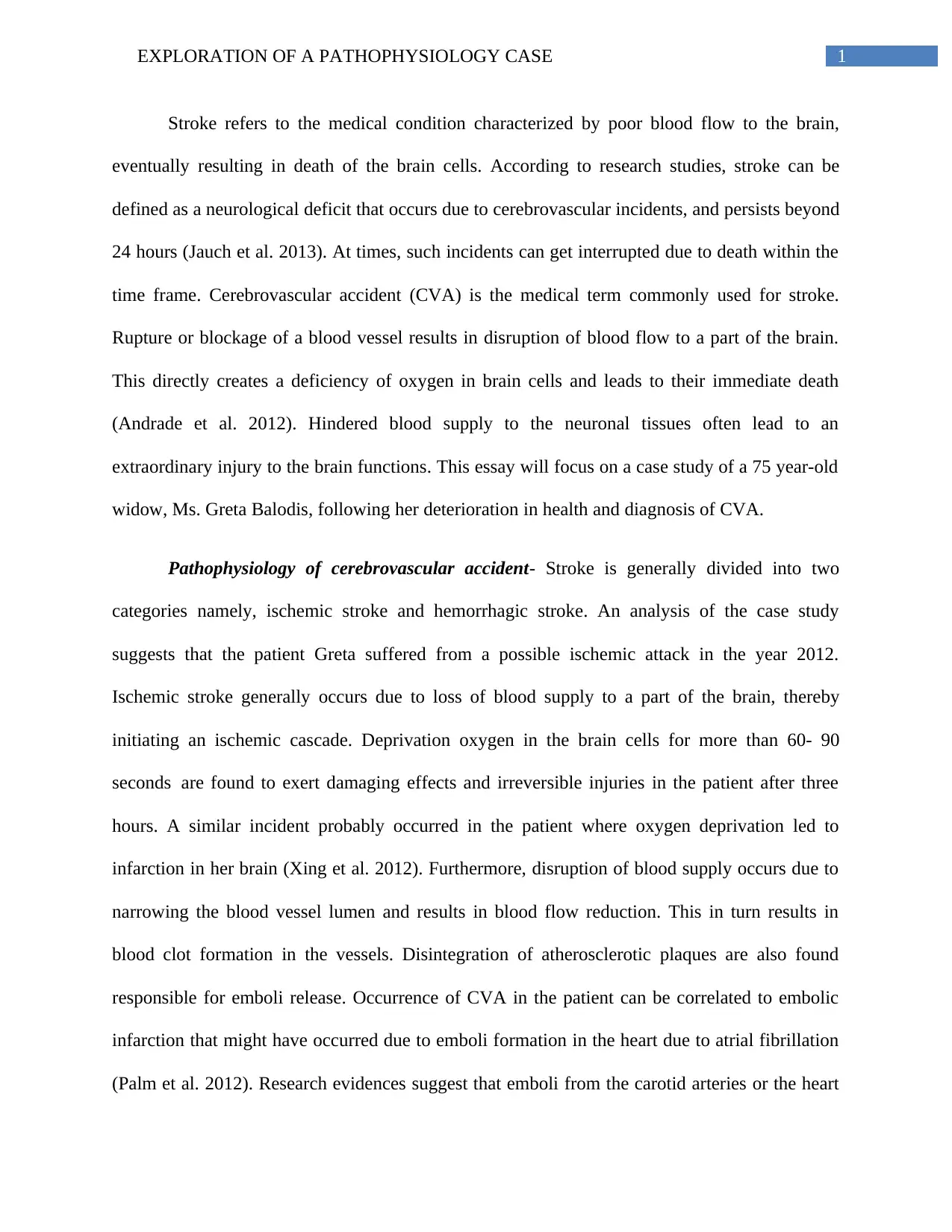
1EXPLORATION OF A PATHOPHYSIOLOGY CASE
Stroke refers to the medical condition characterized by poor blood flow to the brain,
eventually resulting in death of the brain cells. According to research studies, stroke can be
defined as a neurological deficit that occurs due to cerebrovascular incidents, and persists beyond
24 hours (Jauch et al. 2013). At times, such incidents can get interrupted due to death within the
time frame. Cerebrovascular accident (CVA) is the medical term commonly used for stroke.
Rupture or blockage of a blood vessel results in disruption of blood flow to a part of the brain.
This directly creates a deficiency of oxygen in brain cells and leads to their immediate death
(Andrade et al. 2012). Hindered blood supply to the neuronal tissues often lead to an
extraordinary injury to the brain functions. This essay will focus on a case study of a 75 year-old
widow, Ms. Greta Balodis, following her deterioration in health and diagnosis of CVA.
Pathophysiology of cerebrovascular accident- Stroke is generally divided into two
categories namely, ischemic stroke and hemorrhagic stroke. An analysis of the case study
suggests that the patient Greta suffered from a possible ischemic attack in the year 2012.
Ischemic stroke generally occurs due to loss of blood supply to a part of the brain, thereby
initiating an ischemic cascade. Deprivation oxygen in the brain cells for more than 60- 90
seconds are found to exert damaging effects and irreversible injuries in the patient after three
hours. A similar incident probably occurred in the patient where oxygen deprivation led to
infarction in her brain (Xing et al. 2012). Furthermore, disruption of blood supply occurs due to
narrowing the blood vessel lumen and results in blood flow reduction. This in turn results in
blood clot formation in the vessels. Disintegration of atherosclerotic plaques are also found
responsible for emboli release. Occurrence of CVA in the patient can be correlated to embolic
infarction that might have occurred due to emboli formation in the heart due to atrial fibrillation
(Palm et al. 2012). Research evidences suggest that emboli from the carotid arteries or the heart
Stroke refers to the medical condition characterized by poor blood flow to the brain,
eventually resulting in death of the brain cells. According to research studies, stroke can be
defined as a neurological deficit that occurs due to cerebrovascular incidents, and persists beyond
24 hours (Jauch et al. 2013). At times, such incidents can get interrupted due to death within the
time frame. Cerebrovascular accident (CVA) is the medical term commonly used for stroke.
Rupture or blockage of a blood vessel results in disruption of blood flow to a part of the brain.
This directly creates a deficiency of oxygen in brain cells and leads to their immediate death
(Andrade et al. 2012). Hindered blood supply to the neuronal tissues often lead to an
extraordinary injury to the brain functions. This essay will focus on a case study of a 75 year-old
widow, Ms. Greta Balodis, following her deterioration in health and diagnosis of CVA.
Pathophysiology of cerebrovascular accident- Stroke is generally divided into two
categories namely, ischemic stroke and hemorrhagic stroke. An analysis of the case study
suggests that the patient Greta suffered from a possible ischemic attack in the year 2012.
Ischemic stroke generally occurs due to loss of blood supply to a part of the brain, thereby
initiating an ischemic cascade. Deprivation oxygen in the brain cells for more than 60- 90
seconds are found to exert damaging effects and irreversible injuries in the patient after three
hours. A similar incident probably occurred in the patient where oxygen deprivation led to
infarction in her brain (Xing et al. 2012). Furthermore, disruption of blood supply occurs due to
narrowing the blood vessel lumen and results in blood flow reduction. This in turn results in
blood clot formation in the vessels. Disintegration of atherosclerotic plaques are also found
responsible for emboli release. Occurrence of CVA in the patient can be correlated to embolic
infarction that might have occurred due to emboli formation in the heart due to atrial fibrillation
(Palm et al. 2012). Research evidences suggest that emboli from the carotid arteries or the heart

2EXPLORATION OF A PATHOPHYSIOLOGY CASE
are found to break off and enter the bloodstream through cerebral circulation, thereby lodging in
and blocking the blood vessels in the brain (Bailey et al. 2012). The fact that she suffers from
hypertension can also be linked to the pathophysiology of stroke. High blood pressure is found to
damage the arteries present throughout the body, thereby creating conditions that result in their
bursting or clogging. Such weakened arteries present in the human brain increased the likelihood
of the patient to suffer from stroke (Wang et al. 2013). Blockage of blood vessels in the brain
resulted in subsequent energy deprivation, which in turn made the brain resort to adopting an
anaerobic metabolism pathways within the regions containing affected brain tissues. According
to evidences such anaerobic metabolism is found to produce less ATP (Ji et al. 2013). However,
this results in accumulation of lactic acid. Depletion of oxygen or glucose in the brain are
directly responsible for release of glutamate, the excitatory neurotransmitter. Further
pathophysiology mechanism of the CVA suffered by Greta can be linked to producted of reactive
oxygen species and oxygen free radicals that damage the endothelium of the blood vessels, and
trigger an ischemic cascade (Rodrigo et al. 2013).
In addition to causing potential damage to the brain tissues, infarction and ischemia can
also be thought responsible for loss of neuronal structural integrity, facilitated by matrix
metalloprotease release. On the other hand, hemorrhagic strokes most commonly occur due to
ruptured aneurysm, prior ischemic formation, and hypertensive hemorrhage. Previous history of
TIA in the patient might have resulted in injury of the brain tissue, thereby leading to their
compression from an expanding hematoma (Aggarwal et al. 2012). This pressure is also
responsible for disrupting blood supply to the affected parts of the brain, with subsequent
infarction. Thus, the blood released from the part where hemorrhage occurred might have created
toxic effecrs on vasculature and the brain structure (Zis et al. 2013). Greta was reported to suffer
are found to break off and enter the bloodstream through cerebral circulation, thereby lodging in
and blocking the blood vessels in the brain (Bailey et al. 2012). The fact that she suffers from
hypertension can also be linked to the pathophysiology of stroke. High blood pressure is found to
damage the arteries present throughout the body, thereby creating conditions that result in their
bursting or clogging. Such weakened arteries present in the human brain increased the likelihood
of the patient to suffer from stroke (Wang et al. 2013). Blockage of blood vessels in the brain
resulted in subsequent energy deprivation, which in turn made the brain resort to adopting an
anaerobic metabolism pathways within the regions containing affected brain tissues. According
to evidences such anaerobic metabolism is found to produce less ATP (Ji et al. 2013). However,
this results in accumulation of lactic acid. Depletion of oxygen or glucose in the brain are
directly responsible for release of glutamate, the excitatory neurotransmitter. Further
pathophysiology mechanism of the CVA suffered by Greta can be linked to producted of reactive
oxygen species and oxygen free radicals that damage the endothelium of the blood vessels, and
trigger an ischemic cascade (Rodrigo et al. 2013).
In addition to causing potential damage to the brain tissues, infarction and ischemia can
also be thought responsible for loss of neuronal structural integrity, facilitated by matrix
metalloprotease release. On the other hand, hemorrhagic strokes most commonly occur due to
ruptured aneurysm, prior ischemic formation, and hypertensive hemorrhage. Previous history of
TIA in the patient might have resulted in injury of the brain tissue, thereby leading to their
compression from an expanding hematoma (Aggarwal et al. 2012). This pressure is also
responsible for disrupting blood supply to the affected parts of the brain, with subsequent
infarction. Thus, the blood released from the part where hemorrhage occurred might have created
toxic effecrs on vasculature and the brain structure (Zis et al. 2013). Greta was reported to suffer
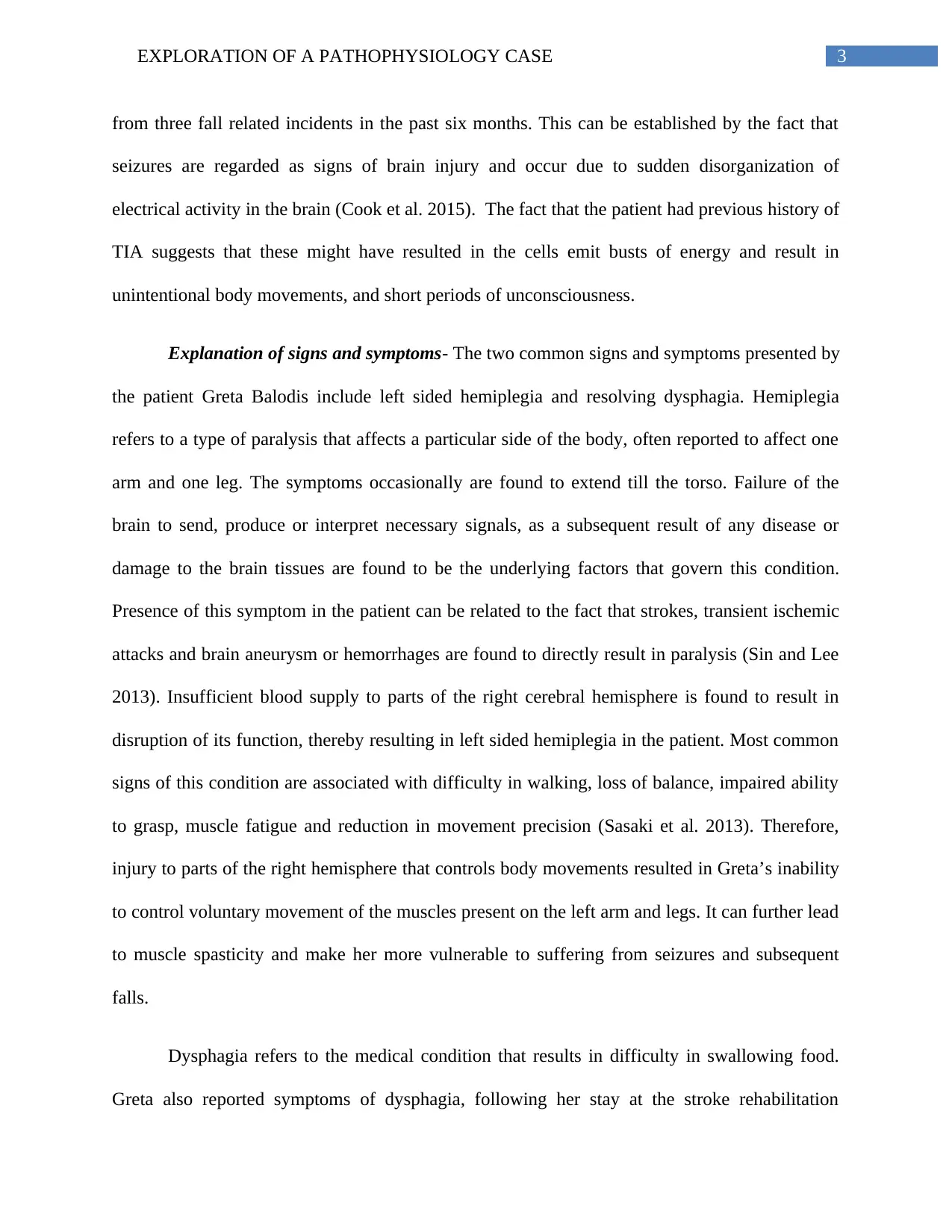
3EXPLORATION OF A PATHOPHYSIOLOGY CASE
from three fall related incidents in the past six months. This can be established by the fact that
seizures are regarded as signs of brain injury and occur due to sudden disorganization of
electrical activity in the brain (Cook et al. 2015). The fact that the patient had previous history of
TIA suggests that these might have resulted in the cells emit busts of energy and result in
unintentional body movements, and short periods of unconsciousness.
Explanation of signs and symptoms- The two common signs and symptoms presented by
the patient Greta Balodis include left sided hemiplegia and resolving dysphagia. Hemiplegia
refers to a type of paralysis that affects a particular side of the body, often reported to affect one
arm and one leg. The symptoms occasionally are found to extend till the torso. Failure of the
brain to send, produce or interpret necessary signals, as a subsequent result of any disease or
damage to the brain tissues are found to be the underlying factors that govern this condition.
Presence of this symptom in the patient can be related to the fact that strokes, transient ischemic
attacks and brain aneurysm or hemorrhages are found to directly result in paralysis (Sin and Lee
2013). Insufficient blood supply to parts of the right cerebral hemisphere is found to result in
disruption of its function, thereby resulting in left sided hemiplegia in the patient. Most common
signs of this condition are associated with difficulty in walking, loss of balance, impaired ability
to grasp, muscle fatigue and reduction in movement precision (Sasaki et al. 2013). Therefore,
injury to parts of the right hemisphere that controls body movements resulted in Greta’s inability
to control voluntary movement of the muscles present on the left arm and legs. It can further lead
to muscle spasticity and make her more vulnerable to suffering from seizures and subsequent
falls.
Dysphagia refers to the medical condition that results in difficulty in swallowing food.
Greta also reported symptoms of dysphagia, following her stay at the stroke rehabilitation
from three fall related incidents in the past six months. This can be established by the fact that
seizures are regarded as signs of brain injury and occur due to sudden disorganization of
electrical activity in the brain (Cook et al. 2015). The fact that the patient had previous history of
TIA suggests that these might have resulted in the cells emit busts of energy and result in
unintentional body movements, and short periods of unconsciousness.
Explanation of signs and symptoms- The two common signs and symptoms presented by
the patient Greta Balodis include left sided hemiplegia and resolving dysphagia. Hemiplegia
refers to a type of paralysis that affects a particular side of the body, often reported to affect one
arm and one leg. The symptoms occasionally are found to extend till the torso. Failure of the
brain to send, produce or interpret necessary signals, as a subsequent result of any disease or
damage to the brain tissues are found to be the underlying factors that govern this condition.
Presence of this symptom in the patient can be related to the fact that strokes, transient ischemic
attacks and brain aneurysm or hemorrhages are found to directly result in paralysis (Sin and Lee
2013). Insufficient blood supply to parts of the right cerebral hemisphere is found to result in
disruption of its function, thereby resulting in left sided hemiplegia in the patient. Most common
signs of this condition are associated with difficulty in walking, loss of balance, impaired ability
to grasp, muscle fatigue and reduction in movement precision (Sasaki et al. 2013). Therefore,
injury to parts of the right hemisphere that controls body movements resulted in Greta’s inability
to control voluntary movement of the muscles present on the left arm and legs. It can further lead
to muscle spasticity and make her more vulnerable to suffering from seizures and subsequent
falls.
Dysphagia refers to the medical condition that results in difficulty in swallowing food.
Greta also reported symptoms of dysphagia, following her stay at the stroke rehabilitation
Secure Best Marks with AI Grader
Need help grading? Try our AI Grader for instant feedback on your assignments.
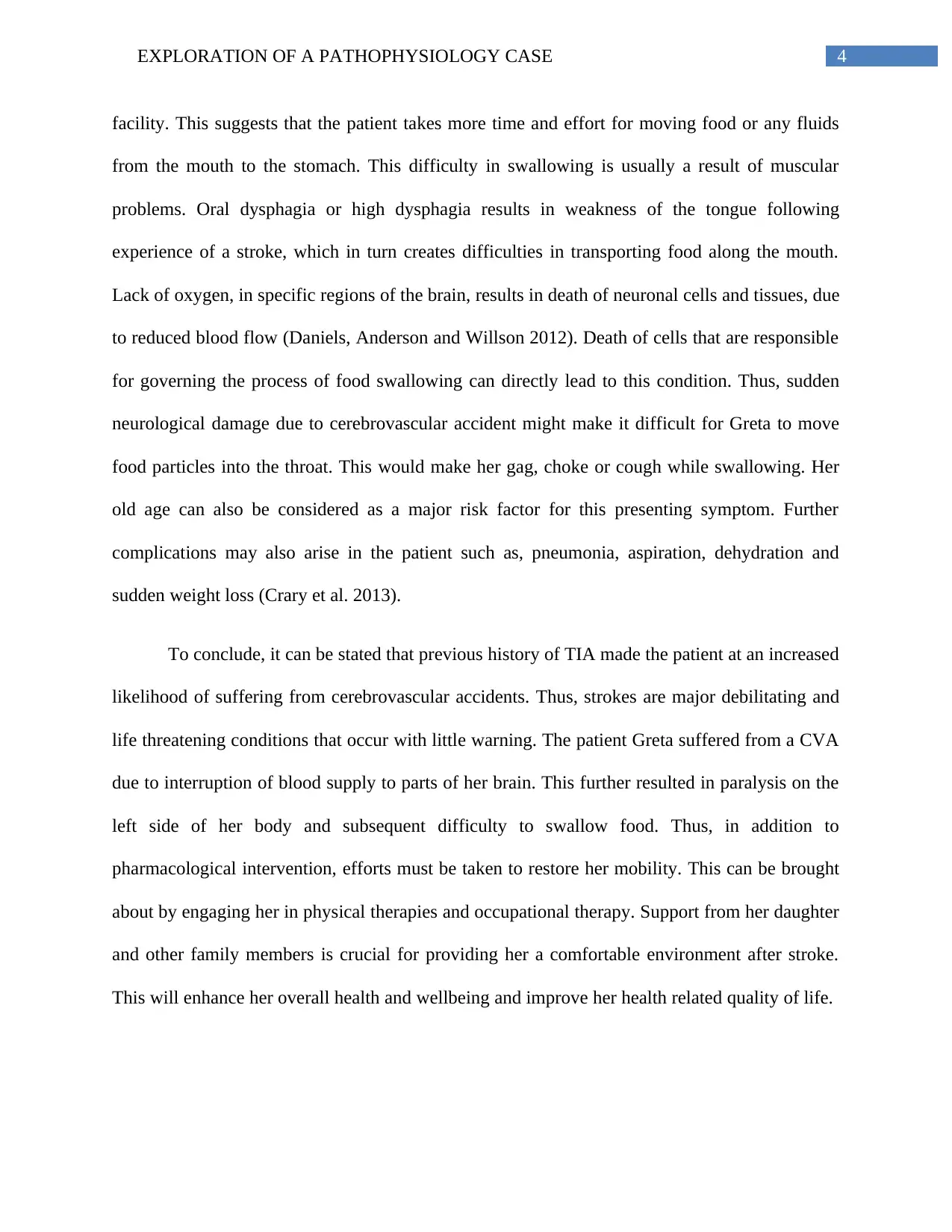
4EXPLORATION OF A PATHOPHYSIOLOGY CASE
facility. This suggests that the patient takes more time and effort for moving food or any fluids
from the mouth to the stomach. This difficulty in swallowing is usually a result of muscular
problems. Oral dysphagia or high dysphagia results in weakness of the tongue following
experience of a stroke, which in turn creates difficulties in transporting food along the mouth.
Lack of oxygen, in specific regions of the brain, results in death of neuronal cells and tissues, due
to reduced blood flow (Daniels, Anderson and Willson 2012). Death of cells that are responsible
for governing the process of food swallowing can directly lead to this condition. Thus, sudden
neurological damage due to cerebrovascular accident might make it difficult for Greta to move
food particles into the throat. This would make her gag, choke or cough while swallowing. Her
old age can also be considered as a major risk factor for this presenting symptom. Further
complications may also arise in the patient such as, pneumonia, aspiration, dehydration and
sudden weight loss (Crary et al. 2013).
To conclude, it can be stated that previous history of TIA made the patient at an increased
likelihood of suffering from cerebrovascular accidents. Thus, strokes are major debilitating and
life threatening conditions that occur with little warning. The patient Greta suffered from a CVA
due to interruption of blood supply to parts of her brain. This further resulted in paralysis on the
left side of her body and subsequent difficulty to swallow food. Thus, in addition to
pharmacological intervention, efforts must be taken to restore her mobility. This can be brought
about by engaging her in physical therapies and occupational therapy. Support from her daughter
and other family members is crucial for providing her a comfortable environment after stroke.
This will enhance her overall health and wellbeing and improve her health related quality of life.
facility. This suggests that the patient takes more time and effort for moving food or any fluids
from the mouth to the stomach. This difficulty in swallowing is usually a result of muscular
problems. Oral dysphagia or high dysphagia results in weakness of the tongue following
experience of a stroke, which in turn creates difficulties in transporting food along the mouth.
Lack of oxygen, in specific regions of the brain, results in death of neuronal cells and tissues, due
to reduced blood flow (Daniels, Anderson and Willson 2012). Death of cells that are responsible
for governing the process of food swallowing can directly lead to this condition. Thus, sudden
neurological damage due to cerebrovascular accident might make it difficult for Greta to move
food particles into the throat. This would make her gag, choke or cough while swallowing. Her
old age can also be considered as a major risk factor for this presenting symptom. Further
complications may also arise in the patient such as, pneumonia, aspiration, dehydration and
sudden weight loss (Crary et al. 2013).
To conclude, it can be stated that previous history of TIA made the patient at an increased
likelihood of suffering from cerebrovascular accidents. Thus, strokes are major debilitating and
life threatening conditions that occur with little warning. The patient Greta suffered from a CVA
due to interruption of blood supply to parts of her brain. This further resulted in paralysis on the
left side of her body and subsequent difficulty to swallow food. Thus, in addition to
pharmacological intervention, efforts must be taken to restore her mobility. This can be brought
about by engaging her in physical therapies and occupational therapy. Support from her daughter
and other family members is crucial for providing her a comfortable environment after stroke.
This will enhance her overall health and wellbeing and improve her health related quality of life.

5EXPLORATION OF A PATHOPHYSIOLOGY CASE
References
Aggarwal, A., Gupta, A., Kumar, S., Baumblatt, J.A., Pauwaa, S., Gallagher, C., Treitman, A.,
Pappas, P., Tatooles, A. and Bhat, G., 2012. Are blood stream infections associated with an
increased risk of hemorrhagic stroke in patients with a left ventricular assist device?. ASAIO
Journal, 58(5), pp.509-513.
Andrade, S.E., Harrold, L.R., Tjia, J., Cutrona, S.L., Saczynski, J.S., Dodd, K.S., Goldberg, R.J.
and Gurwitz, J.H., 2012. A systematic review of validated methods for identifying
cerebrovascular accident or transient ischemic attack using administrative
data. Pharmacoepidemiology and drug safety, 21(S1), pp.100-128.
Bailey, E.L., Smith, C., Sudlow, C.L. and Wardlaw, J.M., 2012. Pathology of lacunar ischemic
stroke in humans—a systematic review. Brain Pathology, 22(5), pp.583-591.
Cook, M., Baker, N., Lanes, S., Bullock, R., Wentworth, C. and Arrighi, H.M., 2015. Incidence
of stroke and seizure in Alzheimer's disease dementia. Age and ageing, 44(4), pp.695-699.
Crary, M.A., Humphrey, J.L., Carnaby-Mann, G., Sambandam, R., Miller, L. and Silliman, S.,
2013. Dysphagia, nutrition, and hydration in ischemic stroke patients at admission and discharge
from acute care. Dysphagia, 28(1), pp.69-76.
Daniels, S.K., Anderson, J.A. and Willson, P.C., 2012. Valid items for screening dysphagia risk
in patients with stroke: a systematic review. Stroke, 43(3), pp.892-897.
Jauch, E.C., Saver, J.L., Adams, H.P., Bruno, A., Demaerschalk, B.M., Khatri, P., McMullan,
P.W., Qureshi, A.I., Rosenfield, K., Scott, P.A. and Summers, D.R., 2013. Guidelines for the
References
Aggarwal, A., Gupta, A., Kumar, S., Baumblatt, J.A., Pauwaa, S., Gallagher, C., Treitman, A.,
Pappas, P., Tatooles, A. and Bhat, G., 2012. Are blood stream infections associated with an
increased risk of hemorrhagic stroke in patients with a left ventricular assist device?. ASAIO
Journal, 58(5), pp.509-513.
Andrade, S.E., Harrold, L.R., Tjia, J., Cutrona, S.L., Saczynski, J.S., Dodd, K.S., Goldberg, R.J.
and Gurwitz, J.H., 2012. A systematic review of validated methods for identifying
cerebrovascular accident or transient ischemic attack using administrative
data. Pharmacoepidemiology and drug safety, 21(S1), pp.100-128.
Bailey, E.L., Smith, C., Sudlow, C.L. and Wardlaw, J.M., 2012. Pathology of lacunar ischemic
stroke in humans—a systematic review. Brain Pathology, 22(5), pp.583-591.
Cook, M., Baker, N., Lanes, S., Bullock, R., Wentworth, C. and Arrighi, H.M., 2015. Incidence
of stroke and seizure in Alzheimer's disease dementia. Age and ageing, 44(4), pp.695-699.
Crary, M.A., Humphrey, J.L., Carnaby-Mann, G., Sambandam, R., Miller, L. and Silliman, S.,
2013. Dysphagia, nutrition, and hydration in ischemic stroke patients at admission and discharge
from acute care. Dysphagia, 28(1), pp.69-76.
Daniels, S.K., Anderson, J.A. and Willson, P.C., 2012. Valid items for screening dysphagia risk
in patients with stroke: a systematic review. Stroke, 43(3), pp.892-897.
Jauch, E.C., Saver, J.L., Adams, H.P., Bruno, A., Demaerschalk, B.M., Khatri, P., McMullan,
P.W., Qureshi, A.I., Rosenfield, K., Scott, P.A. and Summers, D.R., 2013. Guidelines for the
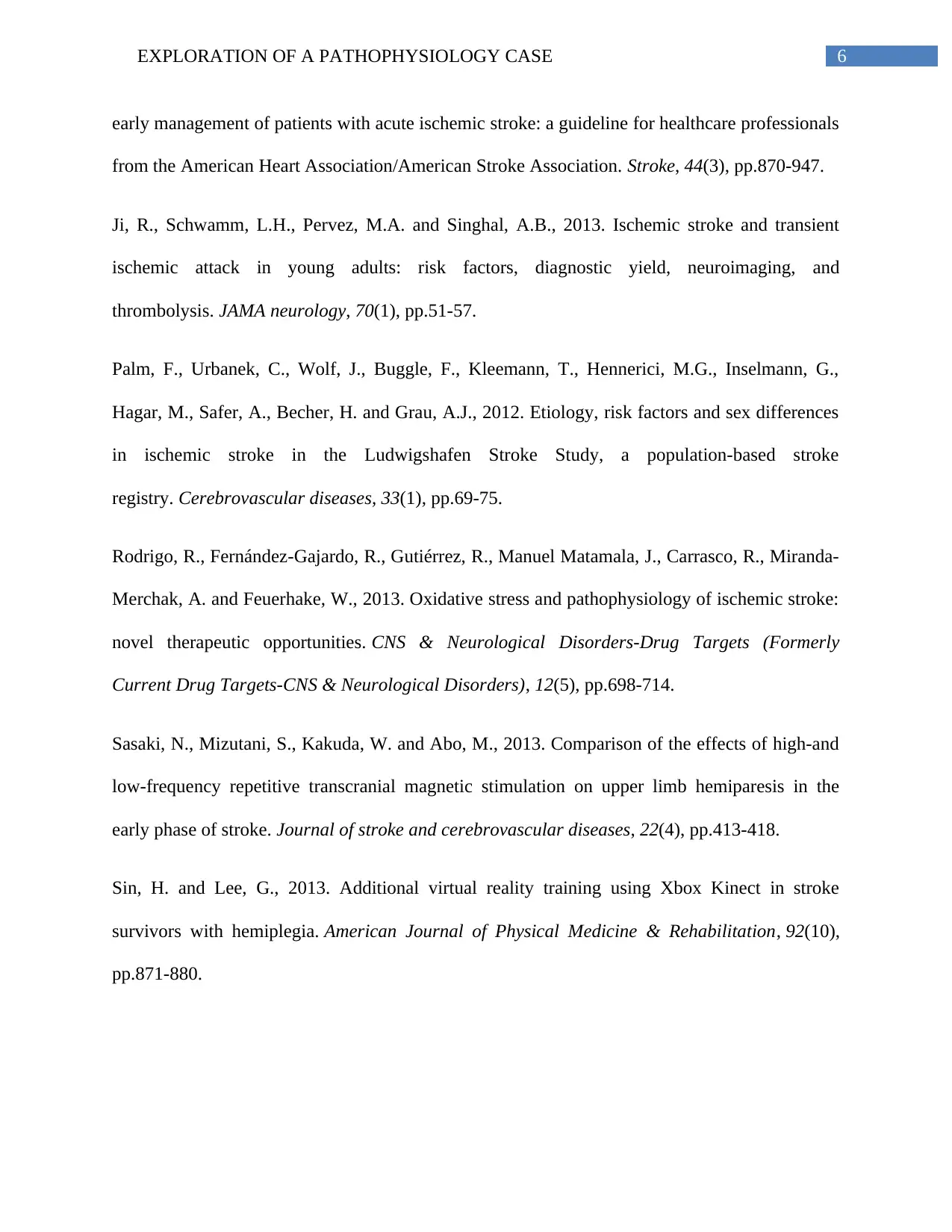
6EXPLORATION OF A PATHOPHYSIOLOGY CASE
early management of patients with acute ischemic stroke: a guideline for healthcare professionals
from the American Heart Association/American Stroke Association. Stroke, 44(3), pp.870-947.
Ji, R., Schwamm, L.H., Pervez, M.A. and Singhal, A.B., 2013. Ischemic stroke and transient
ischemic attack in young adults: risk factors, diagnostic yield, neuroimaging, and
thrombolysis. JAMA neurology, 70(1), pp.51-57.
Palm, F., Urbanek, C., Wolf, J., Buggle, F., Kleemann, T., Hennerici, M.G., Inselmann, G.,
Hagar, M., Safer, A., Becher, H. and Grau, A.J., 2012. Etiology, risk factors and sex differences
in ischemic stroke in the Ludwigshafen Stroke Study, a population-based stroke
registry. Cerebrovascular diseases, 33(1), pp.69-75.
Rodrigo, R., Fernández-Gajardo, R., Gutiérrez, R., Manuel Matamala, J., Carrasco, R., Miranda-
Merchak, A. and Feuerhake, W., 2013. Oxidative stress and pathophysiology of ischemic stroke:
novel therapeutic opportunities. CNS & Neurological Disorders-Drug Targets (Formerly
Current Drug Targets-CNS & Neurological Disorders), 12(5), pp.698-714.
Sasaki, N., Mizutani, S., Kakuda, W. and Abo, M., 2013. Comparison of the effects of high-and
low-frequency repetitive transcranial magnetic stimulation on upper limb hemiparesis in the
early phase of stroke. Journal of stroke and cerebrovascular diseases, 22(4), pp.413-418.
Sin, H. and Lee, G., 2013. Additional virtual reality training using Xbox Kinect in stroke
survivors with hemiplegia. American Journal of Physical Medicine & Rehabilitation, 92(10),
pp.871-880.
early management of patients with acute ischemic stroke: a guideline for healthcare professionals
from the American Heart Association/American Stroke Association. Stroke, 44(3), pp.870-947.
Ji, R., Schwamm, L.H., Pervez, M.A. and Singhal, A.B., 2013. Ischemic stroke and transient
ischemic attack in young adults: risk factors, diagnostic yield, neuroimaging, and
thrombolysis. JAMA neurology, 70(1), pp.51-57.
Palm, F., Urbanek, C., Wolf, J., Buggle, F., Kleemann, T., Hennerici, M.G., Inselmann, G.,
Hagar, M., Safer, A., Becher, H. and Grau, A.J., 2012. Etiology, risk factors and sex differences
in ischemic stroke in the Ludwigshafen Stroke Study, a population-based stroke
registry. Cerebrovascular diseases, 33(1), pp.69-75.
Rodrigo, R., Fernández-Gajardo, R., Gutiérrez, R., Manuel Matamala, J., Carrasco, R., Miranda-
Merchak, A. and Feuerhake, W., 2013. Oxidative stress and pathophysiology of ischemic stroke:
novel therapeutic opportunities. CNS & Neurological Disorders-Drug Targets (Formerly
Current Drug Targets-CNS & Neurological Disorders), 12(5), pp.698-714.
Sasaki, N., Mizutani, S., Kakuda, W. and Abo, M., 2013. Comparison of the effects of high-and
low-frequency repetitive transcranial magnetic stimulation on upper limb hemiparesis in the
early phase of stroke. Journal of stroke and cerebrovascular diseases, 22(4), pp.413-418.
Sin, H. and Lee, G., 2013. Additional virtual reality training using Xbox Kinect in stroke
survivors with hemiplegia. American Journal of Physical Medicine & Rehabilitation, 92(10),
pp.871-880.
Paraphrase This Document
Need a fresh take? Get an instant paraphrase of this document with our AI Paraphraser
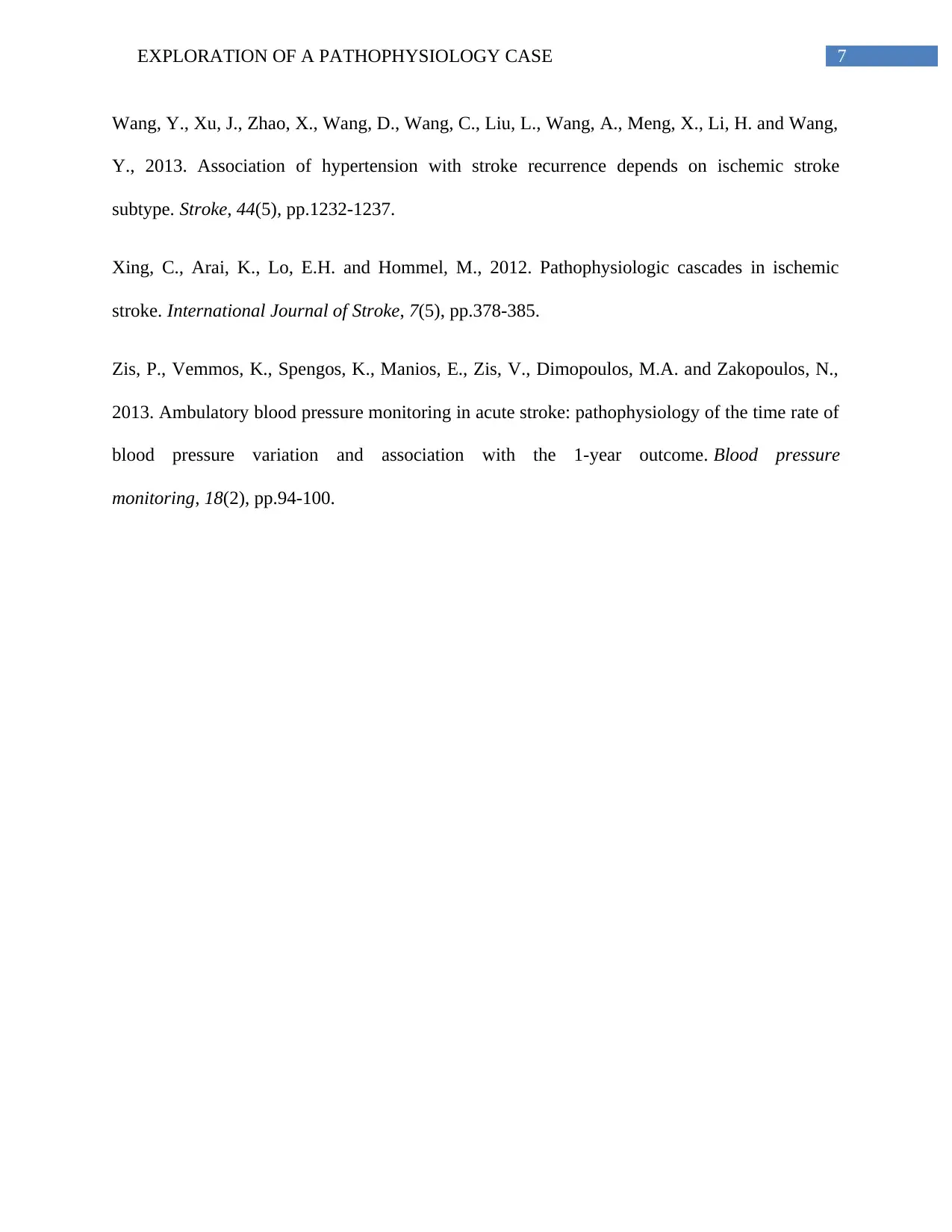
7EXPLORATION OF A PATHOPHYSIOLOGY CASE
Wang, Y., Xu, J., Zhao, X., Wang, D., Wang, C., Liu, L., Wang, A., Meng, X., Li, H. and Wang,
Y., 2013. Association of hypertension with stroke recurrence depends on ischemic stroke
subtype. Stroke, 44(5), pp.1232-1237.
Xing, C., Arai, K., Lo, E.H. and Hommel, M., 2012. Pathophysiologic cascades in ischemic
stroke. International Journal of Stroke, 7(5), pp.378-385.
Zis, P., Vemmos, K., Spengos, K., Manios, E., Zis, V., Dimopoulos, M.A. and Zakopoulos, N.,
2013. Ambulatory blood pressure monitoring in acute stroke: pathophysiology of the time rate of
blood pressure variation and association with the 1-year outcome. Blood pressure
monitoring, 18(2), pp.94-100.
Wang, Y., Xu, J., Zhao, X., Wang, D., Wang, C., Liu, L., Wang, A., Meng, X., Li, H. and Wang,
Y., 2013. Association of hypertension with stroke recurrence depends on ischemic stroke
subtype. Stroke, 44(5), pp.1232-1237.
Xing, C., Arai, K., Lo, E.H. and Hommel, M., 2012. Pathophysiologic cascades in ischemic
stroke. International Journal of Stroke, 7(5), pp.378-385.
Zis, P., Vemmos, K., Spengos, K., Manios, E., Zis, V., Dimopoulos, M.A. and Zakopoulos, N.,
2013. Ambulatory blood pressure monitoring in acute stroke: pathophysiology of the time rate of
blood pressure variation and association with the 1-year outcome. Blood pressure
monitoring, 18(2), pp.94-100.
1 out of 8
Related Documents
Your All-in-One AI-Powered Toolkit for Academic Success.
+13062052269
info@desklib.com
Available 24*7 on WhatsApp / Email
![[object Object]](/_next/static/media/star-bottom.7253800d.svg)
Unlock your academic potential
© 2024 | Zucol Services PVT LTD | All rights reserved.





